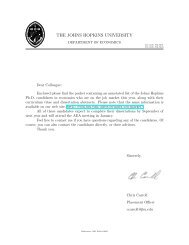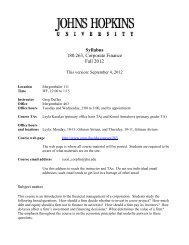WEALTH, DISPOSABLE INCOME AND CONSUMPTION - Economics
WEALTH, DISPOSABLE INCOME AND CONSUMPTION - Economics
WEALTH, DISPOSABLE INCOME AND CONSUMPTION - Economics
You also want an ePaper? Increase the reach of your titles
YUMPU automatically turns print PDFs into web optimized ePapers that Google loves.
consumption, disposable income and total wealth, and a second that enters<br />
human wealth and non-human wealth (excluding equity) separately. As a<br />
basis of comparison, a traditional EC model that excludes wealth is also<br />
estimated.<br />
The dependent variable in all the dynamic equations is the first difference<br />
of consumption, and it depends on the first lag of the OLS estimates<br />
of the residual in the long-run consumption function – the EC term –<br />
and the current and lagged first differences of the long-run determinants of<br />
consumption. The coefficient on the EC term should be significantly less<br />
than zero if c is cointegrated with its long-run explanatory variables. Additional<br />
variables can also be included in the dynamic equation if these variables<br />
are thought to exert a short-run influence on consumption.<br />
Empirical studies over the past decade and a half have furnished an<br />
expansive and colourful menu of would-be regressors that are likely to<br />
contribute to short-run fluctuations in consumption around its long-run<br />
trend. The present analysis, however, confines the specification search to<br />
two of the most popular explanatory variables: the real interest rate and<br />
the unemployment rate or its first difference.<br />
The interest rate is typically included to capture both the wealth<br />
effect associated with revaluations of human and non-human wealth (since<br />
wealth is not usually included in the regression) and the intertemporal<br />
substitution effect associated with fluctuations in the relative price of current<br />
versus future consumption. In principle, the sign of the interest rate<br />
effect is ambiguous, but the usual presumption is that it is negative. The<br />
extended EC models considered here that include wealth provide the<br />
opportunity to separate the revaluation effect from the intertemporal substitution<br />
effect. The unemployment rate is generally thought to proxy<br />
either liquidity effects or uncertainty and its expected sign is therefore<br />
negative.<br />
In order to ensure that the impact of these short-run variables is in<br />
fact confined to the short run, they should be I(0). The real interest rate and<br />
the unemployment rate are therefore pretested for stationarity. Evidence<br />
33




